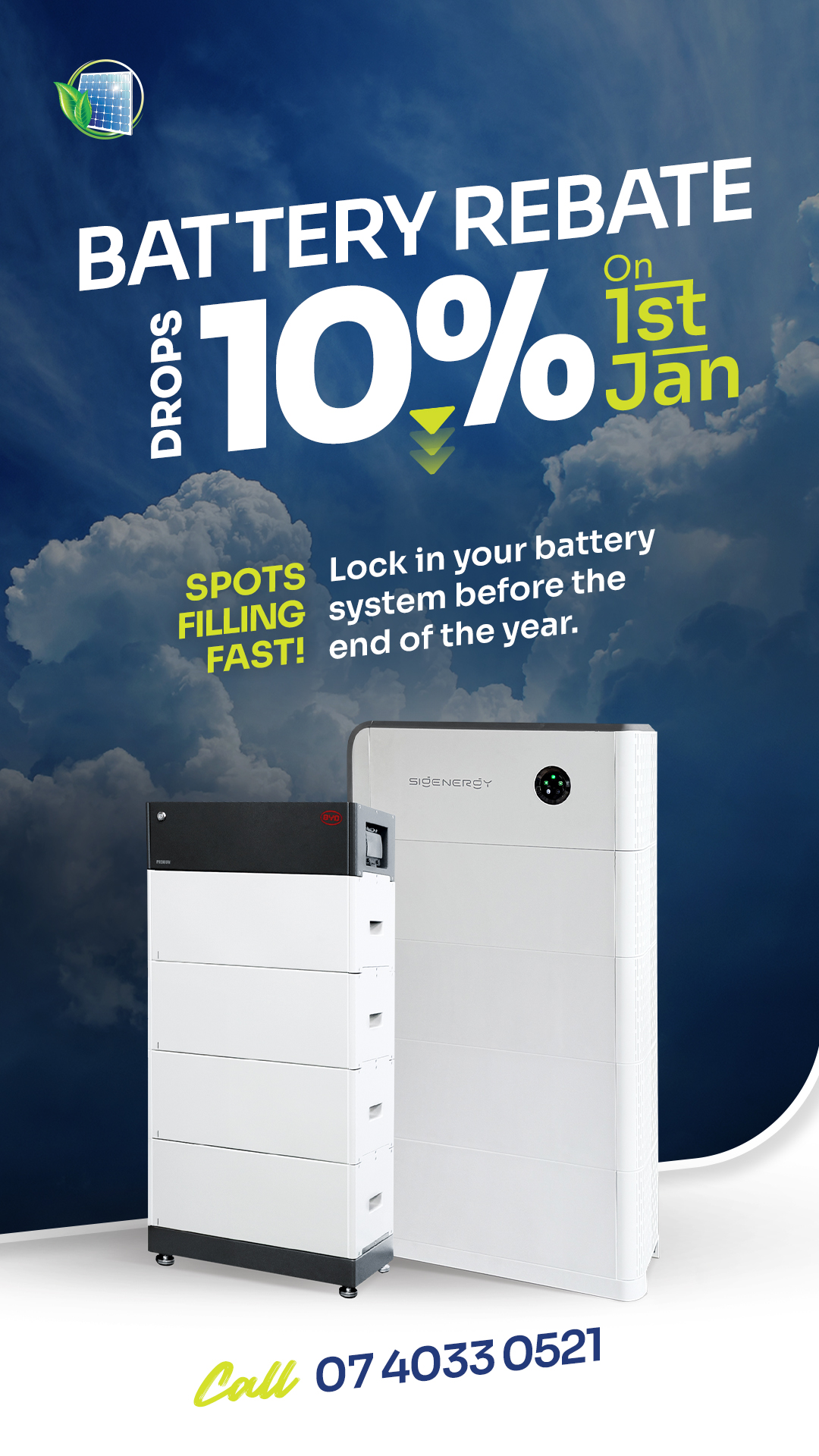
If you’ve been researching solar batteries for your home, you’ve probably come across a bunch of confusing terms like Depth of Discharge, Usable Capacity, and Backup Reserve. They sound technical, and to be fair, they are. But they’re also incredibly important if you want to understand how much energy you’ll actually be able to use from your battery.
I’ve been installing and maintaining solar systems here in Cairns for over a decade, and one thing I’ve learned is this — when customers understand their battery, they’re happier in the long run. Most disappointments happen not because the battery is faulty, but because nobody explained what all those numbers on the spec sheet really mean. So, let’s clear the air and break down these home battery terms in plain Aussie English.
Power vs Energy: What’s the Difference Between kW and kWh?
This is one of the most common questions I get asked, and for good reason those two little letters make a big difference.
Kilowatts (kW) measure power, or how quickly a battery can deliver electricity. Kilowatt-hours (kWh), on the other hand, measure energy, or how much total electricity the battery can store and deliver over time.
The easiest way to picture it is to imagine filling up a bathtub. The power is how wide the tap is, that’s the speed at which water comes out. The energy is how much water ends up in the tub. So, if a sonnenBatterie system has a power rating of 11.5 kW and a usable energy rating of 13.5 kWh, it means it can deliver a lot of power quickly (enough to run your air conditioner and oven at once) and hold enough energy to keep those appliances running for several hours, depending on your usage.
Most Australian homes use somewhere between 25 and 35 kWh of energy per day, though not all at once. That’s why both figures power and energy matter. Your system needs enough power to run your appliances when they’re on, and enough energy to last through the night or a power outage.
Total Battery Capacity vs Usable Battery Capacity
When comparing batteries, one of the sneakiest differences you’ll come across is between total capacity and usable capacity.
Total capacity (sometimes called nominal capacity) is the full amount of energy a battery can technically hold. Usable capacity, however, is the portion of that energy you can actually use in your home. The rest is usually kept in reserve to protect the battery’s internal chemistry and extend its life.
For example, the Tesla Powerwall 3 has a total capacity of 13.5 kWh — and you can use all of it, since it allows for 100% depth of discharge. The Enphase IQ Battery 5P is similar, offering 5.0 kWh total and 5.0 kWh usable. Even Sungrow’s 5 kWh module provides its full 5.0 kWh of usable energy.
When you talk about total vs usable capacity, Sonnen systems are a solid example of clarity (with a few nuances). Sonnen’s batteries (such as the sonnenBatterie line) are built with Lithium Iron Phosphate (LFP) chemistry, which is among the more stable and durable chemistries available.
Sonnen doesn’t typically “hide” a big chunk of the battery behind non-usable buffers—many of their units are marketed to allow near-full depth of discharge. But of course the actual usable capacity will depend on how you configure your system (backup reserve, setpoints, safety margins).
Let’s put that into context: if you had a Sonnen battery with, say, 10 kWh nominal capacity and the system allows 100 % DoD, you might get all 10 kWh usable (less whatever reserve you set). But you should always check the datasheet or software settings to see exactly how much energy is left for daily use. Sonnen publishes detailed technical documents and datasheets for their battery series (Evo, Hybrid, Eco) on their site.
In other words: with Sonnen, the difference between total and usable tends to be small however don’t just assume “full use.” Always clarify in your quotes whether the figure given is usable or nominal because not all batteries can say the same. Some older or cheaper models might only let you use 90–95% of the total capacity. It doesn’t sound like much, but it can make a real difference to your daily savings and the battery’s lifespan. That’s why it’s always worth checking whether the specs you’re reading refer to total or usable capacity.
What Is Depth of Discharge (DoD)?
If you’ve ever seen the term Depth of Discharge (or DoD for short), it refers to how much of your battery’s total capacity you can use before it needs to recharge. The higher the DoD, the more usable energy you get.
For instance, a 10 kWh battery with a 90% DoD means you can safely draw 9 kWh from it before it automatically stops discharging to protect itself. A battery with 100% DoD, like the Powerwall 3, gives you access to the entire 10 kWh.
Here’s the simple maths:
- A 10 kWh battery with 90% DoD = 9 kWh usable.
- A 13.5 kWh battery with 100% DoD = all 13.5 kWh usable.
Generally, most lithium batteries on the market today offer between 90% and 100% DoD. Anything below 90% should raise an eyebrow unless there’s a specific technical reason. It’s also worth noting that some manufacturers tuck this figure away deep in their warranty documents, so don’t be afraid to ask your installer directly.
What Is Backup Reserve — and Why Does It Matter?
Hot tip: If you’re like me, and live somewhere with frequent blackouts (hello, cyclone season in Cairns FNQ), it might be worth keeping a bit more in reserve. But remember, the higher your reserve, the less battery you’ll use day-to-day.
Think of it as an emergency stash:
- If you’ve got a 13 kWh battery and set a 20% reserve, then:
- 2.6 kWh is saved for outages,
- 10.4 kWh is left for everyday use.
A backup reserve is a portion of your battery’s energy that’s saved for emergencies. You can think of it as your “rainy day” stash of power. Let’s say your battery has 13 kWh of usable capacity and you set a 20% backup reserve. That means 2.6 kWh will always be held back for outages, leaving 10.4 kWh available for daily use.
The good news is that most modern batteries let you adjust this setting through an app. If you’re somewhere that rarely loses power, you might set a smaller reserve to get more value day-to-day. If you’re in an area prone to outages, it’s smart to set a higher reserve so you’ve always got something to fall back on when the grid goes down.
It’s worth remembering, though, that the more you save for backup, the less you’ll use each day — so your system might need to be sized up slightly to compensate.
Battery Degradation Over Time
Every battery, whether it’s in your phone, your car, or your solar system loses a bit of capacity over time. This gradual decline is known as degradation, and it’s perfectly normal.
The good news is that modern lithium batteries degrade very slowly, and most come with long-term performance warranties to back that up. The Tesla Powerwall 3, for instance, guarantees at least 70% of its original capacity after 10 years. The Enphase IQ Battery 5P goes even further, offering up to 15 years or 6,000 cycles with a promise of at least 60% remaining capacity. Sonnen’s warranty promises the battery will retain no less than 80% of its nominal capacity after 10 years (or 10,000 cycles), which means if you start with 10 kWh, expect at least 8 kWh left under warranty conditions.
This means that a 13.5 kWh battery might store around 9.5 kWh after ten years of regular use. It’s not a deal-breaker, but it’s something to keep in mind when choosing your system size. If you’re planning to stay in your home long-term, it’s often worth opting for a slightly larger battery so future degradation doesn’t leave you short on storage.
With Sonnen, the warranty and degradation make a real difference. Sonnen offers a 10 year warranty or 10,000 complete recharge cycles (whichever comes first) for many of their batteries.
Under that warranty, Sonnen guarantees that the battery capacity will not fall below 80 % of the nominal capacity during the warranty period (i.e. after 10 years or the specified cycles).
In more plain terms: if you start with a 10 kWh Sonnen battery, Sonnen promises that after 10 years (or 10,000 cycles) it will still hold at least 8 kWh (80 % of 10 kWh), as long as usage and conditions fall within warranty guidelines.
Of course, real-world performance may vary slightly depending on temperature, cycle depth, usage patterns, and system control settings. But Sonnen’s warranty is fairly competitive in the Aussie market. Solar Choice, in their independent review, notes that Sonnen offers a throughput warranty (for total energy cycled over the battery’s life) plus a 10-year product warranty with at least 70 % capacity retention at end of term (for some models).
My Final Thoughts
Understanding home battery terms like usable capacity, depth of discharge, and backup reserve isn’t just for the technically minded, but for anyone who wants to make an informed decision about their solar investment.
To sum it up:
- kW vs kWh: Power is how fast; energy is how much.
- Total vs Usable Capacity: Only part of the battery is for daily use — make sure you know how much.
- DoD (Depth of Discharge): Higher is better — ideally 90% or more.
- Backup Reserve: Saves energy for blackouts but reduces daily usable energy.
- Degradation: Batteries lose storage over time — expect 20–30% after 10–15 years.
When you’re comparing systems, don’t just look at the total capacity figure in big bold letters. Dig a little deeper. Ask your installer how much of that energy is actually usable, whether the DoD is close to 100%, and how much you should hold in reserve for blackouts.
At Hielscher Electrical & Solar, I make sure every customer knows exactly what they’re getting. No vague marketing numbers, no hidden limits, just honest advice and properly explained systems. Because when you understand your battery, you’ll use it smarter and save more.
Ready to Make the Switch?
If you’re thinking about adding a home battery to your solar setup, or if you’ve been wondering whether a Powerwall, Enphase, or SolarEdge battery storage system is the right fit for your home, get in touch. I’ll help you compare options, understand your real energy needs, and find a solution that makes sense for your home and budget.
📞 Give us a ring, shoot us a message, or book a free consult — and let’s design a battery setup that works for you – Get your FREE solar battery design proposal






